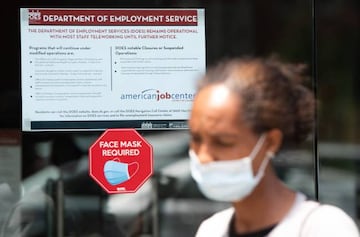Stimulus check: Trump's 'way higher' payment not included in HEROES or HEALS proposals
The U.S. president said he would like to see a second round of stimulus checks increased from $1,200 but current proposals do not include any such plan.

Donald Trump on Thursday announced that he envisaged a second round of stimulus checks could “go way higher” than the first tranche of $1,200 payments sent out under the CARES Act as Republicans and Democrats work towards consensus on the latest economic aid package. However, the U.S. president failed to elaborate on his suggestion during an interview with broadcaster KMID in Texas and it remains unclear as to how any potential increase in a second wave of stimulus checks would be implemented amid a crushing economic downturn and the ongoing coronavirus pandemic.
Both the Democrats and the Republicans have made provisions for another round of checks in their proposals for the latest stimulus package and the amount laid out is one of the few points both parties agree on. The Democrats' HEROES Act, passed in the House of Representatives last May, would release $3 trillion in funds with around $1 trillion set aside for aid to state and local governments struggling with the economic effects of the Covid-19 pandemic.
The Republican response, the HEALS Act, was presented in the Senate on 27 July and closely followed the belt-tightening line prescribed by Senate Majority Leader Mitch McConnell, who is eager to rein in federal spending with the U.S. economy experiencing its worst downturn since the Great Depression. The HEALS Act would release $1 trillion in funding but does not include any further aid to state and local governments beyond a $150 billion grant established under the CARES Act.
Democrats and Republicans agree on $1,200 stimulus check
Both the Republican and Democrat proposals, while $2 billion apart in total expenditure, provide for a second stimulus check of $1,200 for individuals with eligibility criteria much the same as for the first round of checks. However, the Democrats want to see the amount provided for dependents raised from $500 to $1,200 up to a maximum of three, which the Republicans are against.
Treasury Secretary Steven Mnuchin has also intimated that the second round of checks will consist of one-time payments of $1,200.
U.S. economic situation may trump president's plans

While Trump has been a vocal supporter of a larger amount for individuals in a second round of checks, the economic panorama in the U.S. could potentially affect negotiations. GDP shrank at a 32.9 percent annualized rate last quarter, the steepest drop-off in output since records began in 1947, the Commerce Department said on Thursday. The drop in GDP was more than triple the previous all-time decline of 10 percent in the second quarter of 1958.
Democrats and Republicans are aiming to hammer out a finalized deal before the Senate goes into recess on 7 August. Whether Trump’s desire to see the amount provided in a second round of stimulus checks bears fruit remains to be seen, but if it does come to pass the most likely source of the extra cash will be in the form of cuts to other areas of funding currently on the table in both the HEROES and HEALS proposals.
See also
Republicans launch HEALS Act in the Senate
Republicans and Democrats divided on Senate HEALS Act
"The virus is not of natural origin and did not emerge in Wuhan"
Live coverage of the coronavirus crisis
You can follow live, US-focused coverage of the coronavirus crisis with our dedicated live blog.
- USA coronavirus stimulus checks
- Steven Mnuchin
- Mitch McConnell
- Covid-19 economic crisis
- Donald Trump
- Science
- Coronavirus Covid-19
- Economic crisis
- United States
- Pandemic
- Coronavirus
- Recession
- Economic climate
- Virology
- Outbreak
- Infectious diseases
- North America
- Microbiology
- Diseases
- Medicine
- America
- Economy
- Biology
- Health
- Life sciences





